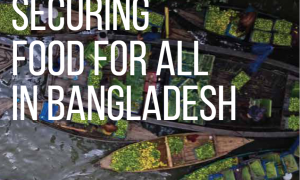Data from 3 irrigation schemes in Mozambique reveal patterns consistent with water inefficiency. A feedback tool could visually communicate ways to conserve by varying water applications at each stage of the crop cycle.
Search
This paper provides a quantitative impact assessment of the community-based integrated natural resources management project (CBINReMP) in the Lake Tana region in Ethiopia during 2011-2019.
Low-cost and sustainable agricultural management practices are being promoted in many countries but continue to face low adoption among farmers.
Migration and gender dynamics of irrigation governance in Nepal
Nepal has a long history of irrigation, including government and farmer-managed irrigation systems that are labor- and skill-intensive. Widespread male migration has important effects on Nepalese society.
Food is the most important basic need for sustenance and survival, and the right to food is among the fundamental human rights.
Securing Food for All in Bangladesh presents an array of research that collectively addresses four broad issues: (1) agricultural technology adoption; (2) input use and agricultural productivity; (3) food security and output markets; and (4) pover
Over the past decade, interest in gender equality and women’s empowerment has grown rapidly, creating a unique opportunity to institutionalize gender research within agricultural research for development.
Technology is the basis for sustainable agricultural growth. Enhanced agricultural productivity and growth depend, to a large extent, upon the widespread adoption of appropriate technologies by farmers.
In Bangladesh, the dry season of October to March is characterised by falling water tables, reduction in the discharge of major rivers, drying water channels, and salinity intrusion, particularly in the southwest coastal region.
Despite declining arable agricultural land, Bangladesh has made substantial progress in boosting domestic food production, improving access to food by increasing household income, and enhancing nutritional outcomes
Agricultural production in Bangladesh has undergone dramatic changes over the past several decades.
Advancing gender equality through agricultural and environmental research: Past, present, and future
Marking a shift away from a traditional focus on how gender analysis can contribute to improved productivity to ask, How does agricultural and environmental research and development contribute to gender equality and women’s empowerment?
Gender relations shape identities, norms, rules, and responsibilities for women and men, and mediate access to, use, and management of water resources, as well as ownership, tenure, and user rights to land and forests (and related infrastructure,
Crop production and farm incomes in two areas of the central dry zone: Findings from June 2021
Using data from six phone survey rounds between June 2020 and June 2021, we found that the impacts of the recent political unrest in Myanmar further compound the disruptions caused by the COVID-19 pandemic, both on the farm as well as on the non-f
Low and variable yields of wheat in the rice--wheat cropping systems of lower Indo-Gangetic Plains (IGP) of South Asia, covering Bihar and Eastern Uttar Pradesh (EUP) in India and the Terai region of Nepal, are a matter of significant concern for
Proposed Balochistan agriculture policy 2021
Balochistan is the largest province of Pakistan comprising 44% of the country’s total land mass with a population of 12.34 million (5.9 percent of total population of the country), its southern border of Balochistan makes up two-thirds (770 KM) of
Assessing the economic cost of depleting groundwater in Balochistan: A Social Accounting Matrix (SAM) multiplier approach
Prolonged droughts and depleting groundwater resources have been a serious challenge to the economy of province of Balochistan, Pakistan.
Integrating institutions into a socio-hydrological model: An example for water quality management in Burkina Faso
The variety of demands that people place on water resources, coupled with the dynamics of the natural system, make water resource management highly complex.

